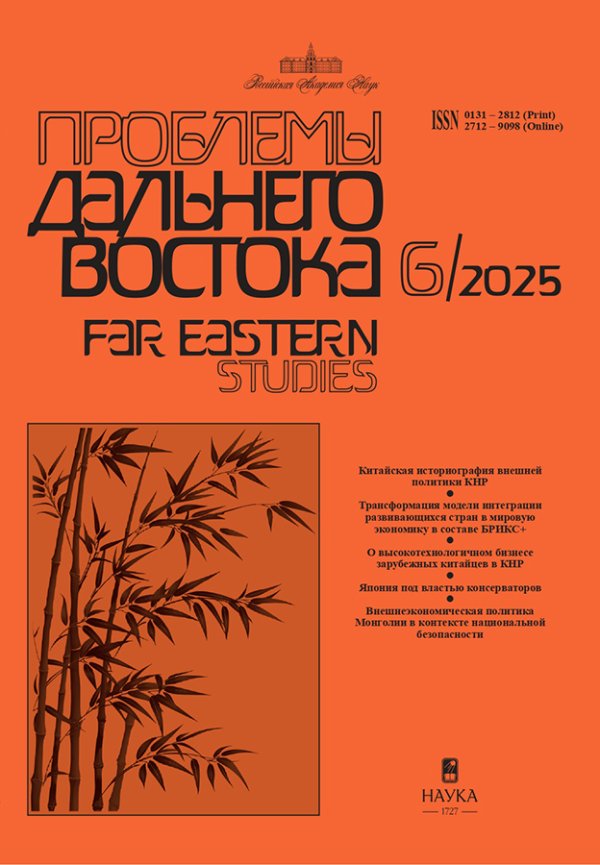Comparative Analysis of the Far East Countries’ Sovereign Debt Risk
- Authors: Balyuk I.A.1, Balyuk M.A.2
-
Affiliations:
- Financial University under the Government of the Russian Federation
- Issue: No 2 (2024)
- Pages: 86-103
- Section: Economics
- URL: https://journals.rcsi.science/0131-2812/article/view/259068
- DOI: https://doi.org/10.31857/S0131281224020079
- ID: 259068
Full Text
Abstract
Due to the changing geopolitical landscape, Russia has been forced to actively establish new international relationships to create conditions for the sustainable development of its national economy and enhance its sovereignty. To promote the development of Russia's Asian regions, it is particularly significant to strengthen cooperation with rapidly growing Asian countries classified as part of the Far East. Sovereign debt risk is an essential consideration when drafting a plan for long-term partnership. This article analyses public debt burdens and determines the level of sovereign debt risk of the Far East countries, which can be considered as current and potential economic partners for Russia. The study showed that the countries of the Far Eastern region — potential partners of Russia have a moderate level of sovereign debt burden. While the highest debt risk was revealed in Mongolia, taking into account the relatively low level of national debt in absolute terms and the downward trend in the public debt to GDP ratio, the overall situation can be considered as manageable. Japan is the most problematic among the countries of the Far Eastern region in terms of the level of sovereign debt risk. But the paradox lies in the fact that all existing debt monitoring systems are focused on a detailed analysis of developing countries and countries with economies in transition, but within the current model of the world order the growth of debt dependence in the developed countries, which set the rules of the game, is not considered as one of the global problems. The rising debt dependence is a global problem that requires comprehensive, coordinated action from the international community. Appropriate mechanisms to manage the global economy and finance in a manner based on the most countries’ interests in the multipolar world should be developed and implemented by G20+ as the most significant international organization today.
About the authors
Igor A. Balyuk
Financial University under the Government of the Russian Federation
Author for correspondence.
Email: balyuk@bk.ru
ORCID iD: 0000-0002-7609-8089
Dr.Sc. (Economics), Associate Professor, Professor
Moscow, Russian FederationMarina A. Balyuk
Email: baljuk@bk.ru
ORCID iD: 0000-0003-2689-9512
Ph.D. (Economics), Independent Expert
References
- Балюк И.А., Балюк М.А. Внешний долг как фактор нестабильности мировой финансовой системы // Финансы. 2023. № 4. С. 57–64.
- Балюк И.А. Внешний долг Китая: современное состояние и перспективы // Проблемы Дальнего Востока. 2020. № 3. С. 83–93. doi: 10.31857/S013128120010554–0
- Галочкин В.Т. Государственный долг ведущих стран мира // Хроноэкономика. 2019. № 6 (19). С. 5–9.
- Голубь А.Б. Дальний Восток или Тихоокеанская Россия: проблема наименования территории (взгляд изнутри) // Вестник Приамурского государственного университета им. Шолом-Алейхема. 2014. № 3 (16). С. 30–36.
- Ревзон О.А. Теория и практика управления государственным долгом России // Вестник университета. 2021. № 3. С. 119–122. doi: 10.26425/1816–4277–2021–3–119–122
- Романцова Т.В. Проблема суверенного долга России // Индустриальная экономика. 2022. № 1. С. 60– 64. doi: 10.47576/2712–7559_2022_1_1_60
- Цвирко С.Э. Актуальные проблемы управления государственным долгом // Актуальные вопросы современной науки. 2016. № 45. С. 200–218.
- Bitner M., Sierak J. Impact of COVID-19 Pandemic on Public Debt — International Perspective // Studies in Logic Grammar and Rhetoric. 2022. Vol. 67. No. 3. Pp. 269–295. doi: 10.2478/slgr-2022–0014
- Ferrarini B., Dagli S., Mariano P. Sovereign debt vulnerabilities in Asia and the Pacific // ADB economics working paper series. April 2023. No. 680. 62 p. doi: 10.22617/WPS230124–2
- Gómez-Puig M., Sosvilla-Rivero S. The Relationship between Public Debt and Economic Growth in Advanced, Emerging and Developing Economies: Differences and Determining Factors. Working Paper 2/2022. Instituto de Estudios Fiscales. 29 p. doi: 10.2139/ssrn.4048038
- Puonti P. Public debt and economic growth // The Research Institute of the Finnish Economy. April 4, 2022. ETLA Report No. 127. 20 p. URL: https://pub.etla.fi/ETLA-Raportit-Reports-127.pdf (дата обращения: 04.01.2024).
- Suryandaru R.A. The relationship between public debt, trade openness, and economic growth in Indonesia: symmetric and asymmetric analysis // Thailand and the World Economy. 2023. Vol. 41. No. 1. Pp. 35–60.
- Zwalf S., Scott R. Public Debt: What Measures Should We Use? A Case Study of Public Debt in Midand Post-pandemic Australia and Its Economic, Policy and Social Consequences // Australian Economic Review. 2022. Vol. 55. No. 4. Pp. 441–460. doi: 10.1111/1467–8462.12482
- Balyuk I.А. Vneshnyj dolg Kitaja: sovremennoe sostojanie i perspektivy [External debt of China: current state and prospects]. Problemy Dal’nego Vostoka. 2020. No. 3. S. 83–93. doi: 10.31857/S013128120010554–0 (In Russ.)
- Balyuk I.А., Balyuk М.А. Vneshnyj dolg kak factor nestabil’nosti mirovoi finansovoi sistemy [External debt as an instability factor of global financial system]. Finansy. 2023. No. 4. S. 57–64. (In Russ.)
- Bitner M., Sierak J. Impact of COVID-19 Pandemic on Public Debt — International Perspective. Studies in Logic Grammar and Rhetoric. 2022. Vol. 67. No. 3. Pp. 269–295. doi: 10.2478/slgr-2022–0014
- Ferrarini B., Dagli S., Mariano P. Sovereign debt vulnerabilities in Asia and the Pacific. ADB economics working paper series. April 2023. No. 680. 62 p. doi: 10.22617/WPS230124–2
- Galochkin V.Т. Gosuderstvennyj dolg vedushchih stran mira [Public debt of the world’s leading countries]. Hronoekonomika. 2019. No. 6 (19). S. 5–9. (In Russ.)
- Golub’ А.B. Dal’nyj Vostok ili Тihookeanskaya Rossiya: problema naimenovaniya territorii (vzgl’ad iznutri) [Far East or Pacific Russia: problem of the territory’s name (inside view)]. Vestnik Priamurskogo gosudarstvennogo universiteta im. Sholom-Аleihema. 2014. No. 3 (16). S. 30–36. (In Russ.)
- Gómez-Puig M., Sosvilla-Rivero S. The Relationship between Public Debt and Economic Growth in Advanced, Emerging and Developing Economies: Differences and Determining Factors. Working Paper 2/2022. Instituto de Estudios Fiscales. 29 p. doi: 10.2139/ssrn.4048038
- Puonti P. Public debt and economic growth. The Research Institute of the Finnish Economy. April 4, 2022. ETLA Report No. 127. 20 p. URL: https://pub.etla.fi/ETLA-Raportit-Reports-127.pdf (accessed: 04.01.2024).
- Revzon О.А. Teorija i praktika upravlenija gosuderstvennym dolgom Rossii [Theory and practice of Russian public debt management]. Vestnik universiteta. 2021. No. 3. S. 119–122. doi: 10.26425/1816– 4277–2021–3–119–122. (In Russ.)
- Romantsova Т.V. Problema suverennogo dolga Rossii [Russia’s sovereign debt problem]. Industrial’naja ekonomika. 2022. No. 1. doi: 10.47576/2712–7559_2022_1_1_60. S. 60–64. (In Russ.)
- Suryandaru R.A. The relationship between public debt, trade openness, and economic growth in Indonesia: symmetric and asymmetric analysis. Thailand and the World Economy. 2023. Vol. 41. No. 1. Pp. 35–60.
- Tsvirko S.E. Aktual’nyje problemy upravlenija gosuderstvennym dolgom [Current problems of public debt management]. Aktual’nyje voprosy sovremennoi nauki. 2016. No. 45. S. 200–218. (In Russ.)
- Zwalf S., Scott R. Public Debt: What Measures Should We Use? A Case Study of Public Debt in Midand Post-pandemic Australia and Its Economic, Policy and Social Consequences. Australian Economic Review. 2022. Vol. 55. No. 4. Pp. 441–460. doi: 10.1111/1467–8462.12482










